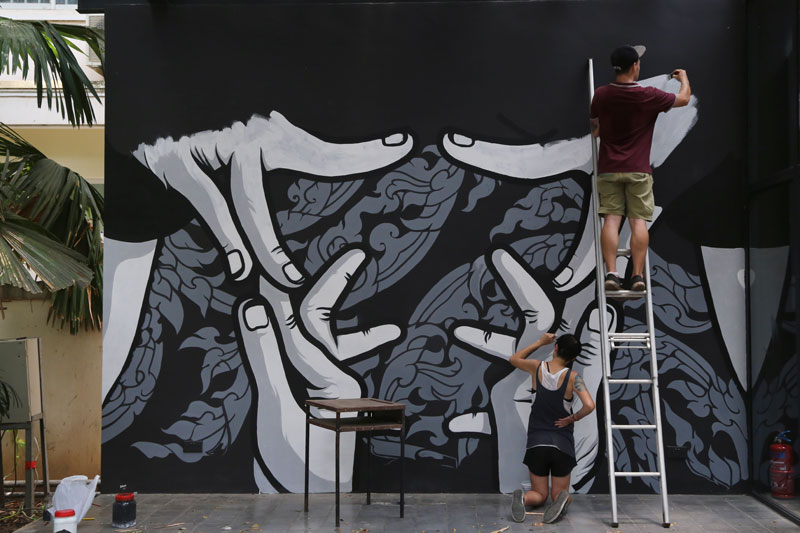On streets, alleyways and rooftops, look out: Nine street artists have unleashed their paintbrushes and spray cans for the first Cambodia Urban Art Festival, covering walls with art at various sites around the capital.
The festival, which began on Thursday, is co-organized by the Institut Francais and two French street artists, Theo Vallier and Chifumi, who like many in his line of work uses a pseudonym.

“The idea is to show to the people around the city what we are doing and what is street art,” Chifumi said in an interview last month.
The pair asked artists from around Cambodia and the world to join them. Local high school students Koy and Davido are presenting their first major commissioned works alongside Cambodian-New Zealanders Peap Tarr and Lisa Mam; Tones, a Cambodian-American; Eltono from France; and Venk of the U.K.
At a time when Phnom Penh is rapidly developing, the festival aims to make street art a creative part of that change, the organizers say.
“The city is changing a lot. Everything is moving,” Mr. Vallier said last week. “We are just thinking that street art can be one part of the process, of the evolution of the city.”
For 17-year-old Davido, that intersection of art and urbanism inspired his mural in an alley off Street 19.
“I wanted to showcase a meaning, or a theme, of fear: fear of losing something,” he said between brushstrokes. “So what I have is a snake wrapping itself around a building while at the same time other buildings are falling, so it’s trying to protect that building from collapsing.”
The geometric mural, he said, reflects his thoughts about Phnom Penh and Cambodia as a whole.
“We’re in a developing country, and at times I feel like we’re developing too fast, where people are just looking toward the future and not keeping an eye on the past,” he said.
Popularizing street art has not been easy in Phnom Penh, the artists say, where graffiti is usually seen as either vandalism or a baffling pursuit of foreign artists.
“The culture is really, really different,” Chifumi said. “When we paint on the street, on the walls, the people don’t understand because they don’t have the keys, the tools to understand that. So we want to give them the tools.”
Armed with paint, brushes and copious bottles of water, the artists have spent the past two weeks painting in the April heat, some integrating Cambodian elements into their pieces to adapt the art to its environs.
Venk, who moonlights as a drawing instructor at Limkokwing University under his real name, Victor Blanco, asked his students to help him with a surrealist mural of Phnom Penh at Le Moon rooftop bar on Sisowath Quay. Koy painted a vibrant portrait of 1960s pop darling Ros Sereysothea at the NGO and skate shop Skateistan, while Mr. Vallier and Chifumi looked to traditional Khmer patterns and icons for their creations at the Institut Francais.
And while graffiti artists are notoriously indifferent to authority—if not outright defiant—Mr. Vallier said he wanted street art’s growth and that of the city to be symbiotic, and the festival organizers had to obtain permission from the municipal government.
“We are trying to start a dialogue between [the municipal government] and us to be sure that they know what we are doing, that we are not here to dirty the city,” Mr. Vallier said, a message he hopes will also reach the Cambodian public.
“We would like [the public] to like what we are doing, to be part of it and to take it up as their own thing,” he said.
At the very least, Mr. Vallier said, he hoped the festival would encourage residents to look around and appreciate the bursts of color in a changing cityscape.
“We want them to react to what we are doing,” he said. “Like every art piece, they are in front of something and they can think by themselves if they like it, if they don’t like it, whatever they think about it.
“I don’t know if they approve or not, but there’s a connection.”